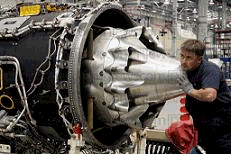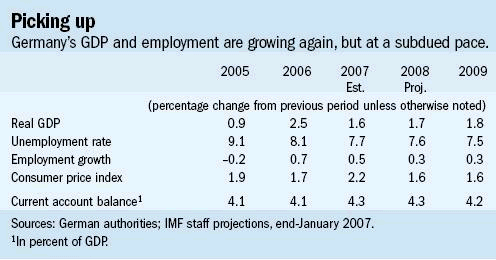
Typical street scene in Santa Ana, El Salvador. (Photo: iStock)
IMF Survey: Germany: Recovering But Still Highly Regulated
February 12, 2007
- A series of shocks undermined competitiveness in the early 1990s
- Little leeway for fiscal policy to stimulate domestic demand this decade
- Tackling long-term unemployment has been expensive and not fully successful
A brisk economic recovery is under way in Germany, ending a period of subdued and uneven growth that persisted for a decade despite a strong performance from exports.

Worker at Berlin aircraft engine factory, where much of production is for export (photo: Sean Gallup/Getty Images)
EUROPEAN FOCUS
In previous business cycles, export growth typically led to general economic recovery within six to nine months. But export industries had to adjust after facing competitiveness problems in the early 1990s, and the same adjustments that helped exporters—wage moderation and a substantial reduction in the workforce—held down domestic demand. That meant the economy was unable to absorb all those workers who lost jobs in export industries as well as in the construction sector, which had a long decline.
Recently, an upswing in investment, coupled with the strong export sector, has sparked a cyclical recovery, resulting in the first increase in full-time employment in five years. However, consumption demand has remained moderate, because of both continued wage moderation and fiscal reforms that have reduced government spending in anticipation of higher costs from an aging population.-
Germany still remains a highly regulated economy and needs to undertake further reforms to address low trend growth, high structural unemployment, and the fiscal risks posed by an aging population and still-high social spending.
The export sector adjusted
A series of shocks undermined competitiveness in the early 1990s. Unit labor costs rose as a result of the wage boom that followed the 1990 unification of East and West Germany. Moreover, because West German labor market institutions, such as restrictions on hiring and firing, were almost universally extended to the former East Germany, firms there could not reduce employment fast enough to close the productivity gap. The pressures of globalization and European Union expansion on industries further aggravated the loss of competitiveness and set the stage for profound adjustment.
Because of restraints on fiscal policy and a fixed exchange rate (following the inception of the euro), that adjustment relied almost exclusively on slowing inflation and wage growth relative to euro area partners. Indeed, over the past 10 years, Germany's nominal wages grew 9 percent less than the average wage in the euro area (see chart).
The export sector took the lead in restructuring. Confronted with strong external competition, it shifted production abroad. Export-oriented industries cut back investment in Germany and extensively reduced domestic employment. The manufacturing sector, for example, has lost nearly 40 percent of its workforce since the early 1990s. Given the opportunity to tap into less expensive and increasingly productive labor abroad, corporations sought domestic labor concessions to maintain production and employment at home. As a result, nominal wage growth has moderated to 2 percent annually this decade, barely exceeding inflation. The resulting decline in unit labor costs bolstered profit margins, boosted corporate sector profits, and helped restore external competitiveness.
The domestic economy did not
But domestic activities that faced less international competition—notably in the service sector—have been slower to reform. The less dynamic domestic economy was unable to employ workers who lost their jobs in the export and construction sectors, fueling unemployment and a gradual slowing of wage increases. It is only recently that unit labor costs in the overall economy have shown signs of stabilizing, an indication of how much slower adjustment has been in the service sector. Indeed, service sector profitability continues to trail the manufacturing sector: real operating profits in the service sector remained virtually unchanged between 1996 and 2005, while in the manufacturing sector they rose by 77 percent.

There has been little leeway for fiscal policy to stimulate domestic demand this decade. Amid legacy costs of East-West unification (annual subsidies of approximately 4 percent of GDP), insufficient adjustment during earlier upswings, tax cuts in 2001, 2004, and 2005 equivalent to about 2 percent of GDP, weakening trend growth, and aging-related expenditure pressures, the fiscal deficit breached the criterion set down by the Maastricht Treaty for the fourth consecutive year in 2005. Most important, however, the persistent weakness in employment and domestic demand in turn caused a pronounced erosion in the major tax bases—labor income and consumption.
The authorities responded to these challenges with significant expenditure cuts. The previous government's "Agenda 2010" reforms cut social expenditure, including pensions. These were continued in 2006 by the current coalition government. The expenditure cuts largely offset the stimulus from lower taxation, and the structural deficit stabilized during 2003-04 before registering an improvement in 2005-06.
Without deeper structural change, Germany's long-term growth potential is likely to remain subdued. Although external competitiveness has been restored, domestic efficiency and labor utilization remain low. The current cyclical recovery provides a favorable setting to tackle Germany's structural and fiscal problems. Reforms should be bold and well coordinated to allow Germany to catch up with the increase in living standards other leading economies have achieved over the past decade.
Structural unemployment must be tackled
To broaden the recovery, employment growth needs to accelerate to generate higher household income and consumption. The recent uptick in full-time jobs is encouraging. However, to reduce structural unemployment, there must be changes in generous welfare policies that elevate reservation wages (those at which workers are willing to take a job), especially among low-skilled workers.
Efforts to tackle the core problem of long-term unemployment have been expensive and not fully successful. Improving the functioning of the unemployment insurance system should be a top priority. As recommended by the Council of Economic Experts and several research institutes, unemployment allowances should be cut until there is a demonstrated effort to find work. More generally, Germany's active labor market programs and regulations tend to be complex, expensive, and ineffective. It would be better to eliminate those that are ineffective, and simplify those that are retained to increase transparency—and usefulness—for job seekers.
Product and service market deregulation needs to aim at strengthening competition and raising productivity. Because productivity ultimately determines the standard of living, greater reliance on efficiency gains would put less burden on the need for wage moderation. Ample scope remains to improve competition in network industries (mainly gas, electricity, and telephone).
Capital markets are deepening
A more efficient financial sector would also help to strengthen economic performance. Banks and insurance companies are healthier than in recent years, but the improvement in their earnings is largely cyclical and they still underperform most EU peers. There is ample leeway to attract more private capital to public sector banks to harness market signals and facilitate restructuring. Capital markets are deepening and playing a greater role in guiding corporate decisions. The authorities intend to formulate a more effective legal framework for private equity, recognizing that such financing can facilitate the entry of new firms, spur innovation, and enhance corporate governance.
Good progress was made in reducing the fiscal deficit in 2006, and policies are in place for further adjustment in 2007. Although expenditure measures should continue to be the cornerstone for lasting fiscal adjustment, the VAT increase that took effect this year, combined with a reduction in payroll taxes, is a welcome structural measure. Strong revenue growth in the current upswing should be used to reduce debt and prepare for the future.
Beyond 2007, the deficit could begin to rise again as the population continues to age. To prepare, authorities should aim for structural fiscal balance by 2010. To achieve this, further cuts can be made in subsidies and tax expenditures, spending on active labor market programs, and unemployment costs. Measures should also continue to recalibrate future entitlement costs.








